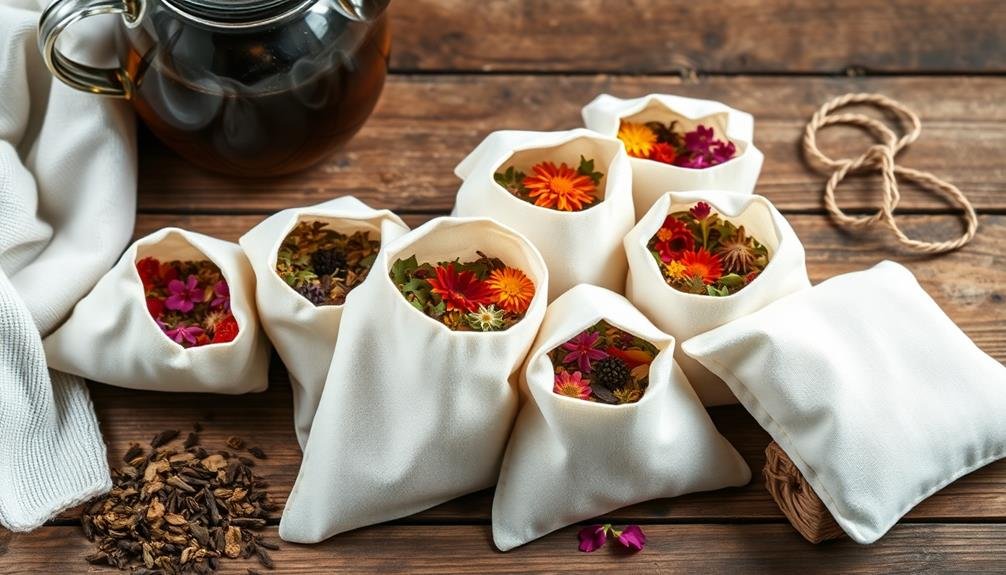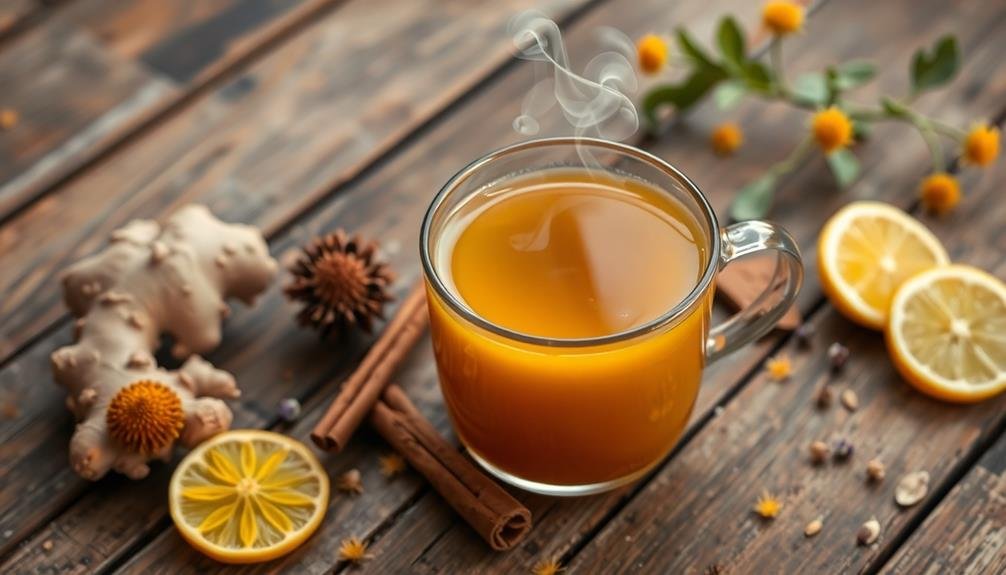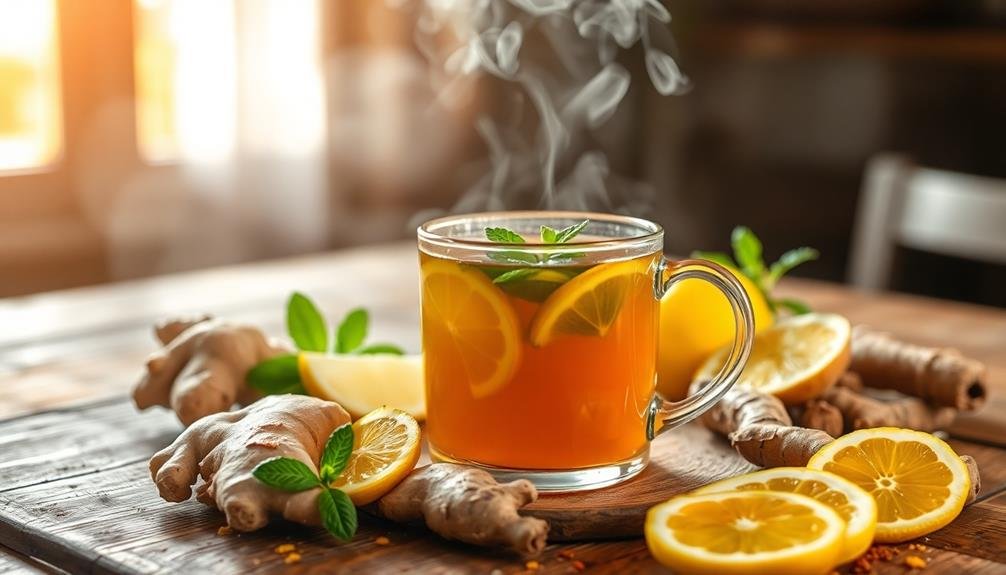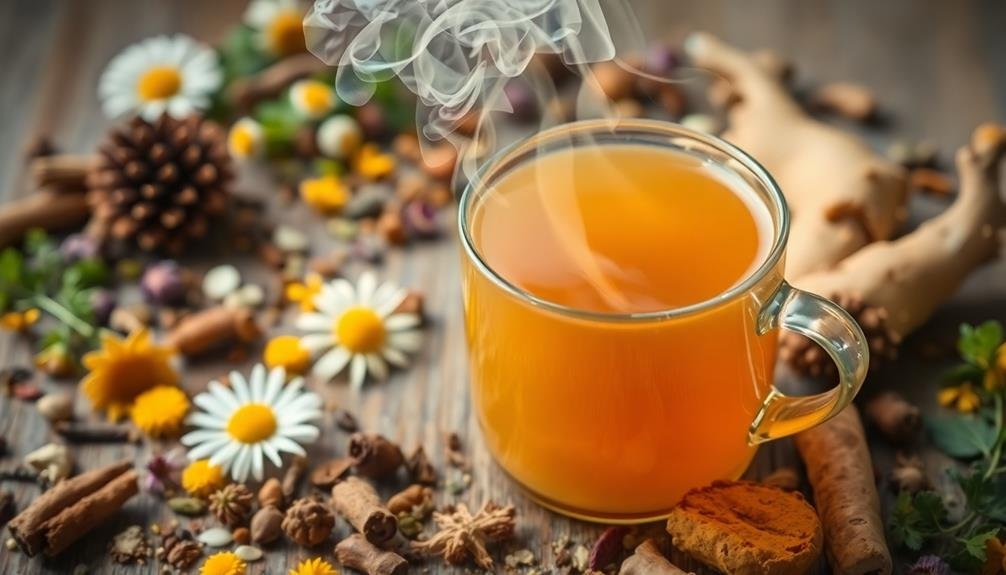You can create eco-friendly DIY tea bags for your custom blends using various sustainable materials. Options include cotton muslin pouches, reusable mesh sachets, drawstring linen bags, and biodegradable filter paper pouches. For a more durable choice, consider hemp cloth infusers, organic cotton gauze bags, or silicone tea strainers. Stainless steel mesh infusers offer longevity, while recycled paper filters provide a disposable yet eco-conscious alternative. These options allow you to enjoy your favorite tea blends while reducing environmental impact. Each method offers unique benefits regarding reusability, ease of use, and sustainability, catering to different preferences and brewing styles.
Cotton Muslin Tea Pouches

Cotton muslin tea pouches offer a simple and sustainable alternative to disposable tea bags. These reusable pouches are easy to make and perfect for brewing your favorite loose leaf teas.
To create your own, you'll need unbleached cotton muslin fabric, scissors, and a sewing machine or needle and thread.
Cut the muslin into small squares, about 3 inches on each side. Fold each square in half and sew two sides together, leaving the top open. Turn the pouch inside out to hide the seams. You can add a drawstring by sewing a small channel along the top edge and threading a cotton string through it.
To use your cotton muslin tea pouch, simply fill it with your desired amount of loose tea leaves and cinch it closed. The fine weave of the muslin allows water to flow through while containing the tea leaves.
After brewing, empty the used leaves into your compost bin and rinse the pouch. These pouches can be washed and reused many times, reducing waste and allowing you to enjoy your favorite teas in an eco-friendly manner.
Reusable Mesh Fabric Sachets
Another eco-friendly option for DIY tea bags is reusable mesh fabric sachets. These lightweight, durable pouches are perfect for loose leaf teas and herbal blends.
You'll find them made from food-grade nylon or polyester mesh, which allows ideal water flow for full flavor extraction.
To use mesh sachets, simply fill them with your desired tea blend and seal them shut. Most designs feature a drawstring closure or a zip-lock mechanism for easy filling and cleaning.
You can steep these sachets directly in your cup or teapot, just like traditional tea bags.
After use, rinse the sachet thoroughly and let it air dry. You'll be able to reuse these sachets numerous times, making them a cost-effective and environmentally friendly choice.
They're also great for travel, as you can pre-fill several sachets with different blends for convenience.
When shopping for mesh sachets, look for ones that are BPA-free and heat-resistant. Some brands offer various sizes to accommodate different tea amounts.
You can even find biodegradable options made from plant-based materials for an even greener tea experience.
Drawstring Linen Tea Bags

Elegance meets sustainability with drawstring linen tea bags. These reusable pouches offer a refined way to steep your favorite loose-leaf blends while reducing waste.
You'll find that linen's natural properties make it an excellent choice for tea infusion, as it's durable, heat-resistant, and doesn't impart any unwanted flavors to your brew.
To create your own drawstring linen tea bags, you'll need unbleached linen fabric, cotton thread, and a sewing machine. Cut the linen into small rectangles, fold them in half, and sew the sides to form a pouch. Leave the top open and create a channel for the drawstring.
Thread a cotton string through this channel, and you've got a functional, eco-friendly tea bag.
These linen bags are perfect for larger tea leaves and herbal blends that need room to expand. You can easily adjust the size to accommodate different quantities of tea.
After use, simply rinse the bag, let it dry, and it's ready for your next cup. With proper care, these drawstring linen tea bags will last for years, making them a sustainable choice for tea enthusiasts.
Biodegradable Filter Paper Pouches
You'll need biodegradable filter paper, scissors, and food-safe glue to create these eco-friendly tea pouches.
Start by cutting the filter paper into small rectangles and folding them to form a pouch shape.
You'll then carefully seal the edges with glue and let them dry before filling with your favorite loose tea and storing in an airtight container.
Materials and Preparation
To kick off your DIY eco-friendly tea bag project, you'll need to gather the right materials for creating biodegradable filter paper pouches. Start with unbleached, chlorine-free filter paper, which you can find at specialty coffee shops or online retailers.
You'll also need organic cotton thread, scissors, and a stapler or sewing machine for sealing the pouches.
Before you begin, thoroughly wash your hands and sanitize your work surface. Cut the filter paper into 3×4 inch rectangles, allowing enough material to fold and seal. If you're using a stapler, verify it's food-grade stainless steel to prevent rust. For sewing, opt for a natural, undyed cotton thread.
Prepare your loose tea blends in advance, using organic and locally sourced ingredients when possible. Measure out about 1-2 teaspoons of tea per bag, depending on your preferred strength.
Keep your tea leaves in airtight containers to maintain freshness until you're ready to fill the pouches.
Folding and Assembly Techniques
Creating biodegradable filter paper pouches involves three main folding and assembly techniques.
The first method is the classic pyramid shape. You'll start with a square piece of filter paper, fold it diagonally, then bring the corners up to form a triangle. Secure the edges with a running stitch or food-safe glue, leaving the top open for filling.
The second technique is the rectangular pouch. Fold a rectangular piece of filter paper in half, then stitch or glue along two sides, creating a pocket. Leave the top open for adding your tea blend. This shape works well for larger loose-leaf teas.
The third method is the circular tea bag. Cut two circles of filter paper, place your tea blend in the center of one, then lay the second circle on top. Use a circular object to press the edges together, sealing them with heat or a food-safe adhesive. This design allows for maximum infusion.
For all techniques, guarantee you leave enough space for the tea to expand when steeping.
You can attach a string and label to each pouch for easy handling and identification of your custom blends.
Sealing and Storage Tips
Proper sealing and storage are essential for maintaining the freshness and quality of your homemade biodegradable tea bags. To seal your tea bags, you'll need to use a method that's both effective and eco-friendly.
Consider using a small iron to heat-seal the edges of your filter paper pouches. Alternatively, you can use unbleached cotton thread to sew the edges closed. Avoid using staples or adhesives, as these may not be compostable.
Once sealed, store your tea bags in an airtight container to protect them from moisture and odors. Glass jars or tin containers work well and can be reused. Keep the container in a cool, dry place away from direct sunlight to preserve the tea's flavor and aroma.
If you've made multiple varieties, label each container clearly to avoid confusion.
For long-term storage, you can vacuum-seal batches of tea bags to extend their shelf life. This method is particularly useful if you've made a large quantity or want to gift your homemade tea bags.
Remember to use the oldest tea bags first to guarantee you're always enjoying the freshest blends.
Hemp Cloth Tea Infusers

Hemp cloth tea infusers offer you a sustainable and biodegradable alternative to disposable tea bags.
You'll find these reusable pouches easy to clean, allowing for multiple uses without compromising tea quality.
Their long-lasting and durable nature makes them an excellent investment for eco-conscious tea drinkers looking to reduce waste.
Sustainable and Biodegradable Option
Discover a sustainable and biodegradable alternative to traditional tea bags with hemp cloth tea infusers. These eco-friendly options allow you to enjoy your favorite loose-leaf teas while minimizing environmental impact. Hemp cloth is naturally antimicrobial, durable, and free from harmful chemicals, making it an excellent choice for brewing your custom blends.
To create your own hemp cloth tea infusers, you'll need:
| Material | Tools | Optional |
|---|---|---|
| Hemp cloth | Scissors | Embroidery kit |
| Organic thread | Sewing machine | Fabric dye |
| Drawstring | Needle and pins | Essential oils |
| Tea blend | Iron | Herb stamps |
Cut the hemp cloth into small squares or circles, depending on your preferred shape. Fold the edges and sew them to prevent fraying. Attach a drawstring for easy handling and removal. You can personalize your tea infusers by embroidering designs, using fabric dye, or adding a few drops of essential oils for extra aromatherapy benefits.
Hemp cloth tea infusers are reusable, washing easily between uses. They're also compostable at the end of their lifecycle, ensuring a truly sustainable tea-drinking experience.
Easy to Clean
One of the most appealing aspects of hemp cloth tea infusers is their ease of cleaning. Unlike disposable tea bags, these reusable infusers are simple to maintain, ensuring you can enjoy your favorite blends without the hassle of complex cleaning routines.
After brewing your tea, you'll find that cleaning your hemp cloth infuser is a breeze. Simply empty the used tea leaves into your compost bin or garden, then rinse the infuser under running water.
For a more thorough cleaning, you can gently scrub it with a soft brush or sponge using mild, eco-friendly soap.
You'll appreciate that hemp cloth doesn't retain odors or stains, so your infuser won't affect the taste of different tea varieties. To dry your infuser, just hang it up or lay it flat on a clean surface.
For occasional deep cleaning, you can boil the infuser in water for a few minutes or run it through a hot cycle in your dishwasher.
Long-Lasting and Durable
Among the many benefits of hemp cloth tea infusers, their exceptional durability stands out. You'll find these eco-friendly alternatives to disposable tea bags can withstand repeated use without deteriorating. Hemp fibers are naturally strong and resistant to wear, ensuring your tea infuser remains intact even after countless steeping sessions.
Unlike paper tea bags that tear easily, hemp cloth infusers maintain their structural integrity over time. You won't need to worry about replacing them frequently, saving you money and reducing waste. The sturdy nature of hemp also means these infusers can handle various tea types, from fine loose leaf to coarser herbal blends.
To maximize the longevity of your hemp cloth tea infuser, rinse it thoroughly after each use and allow it to air dry completely. With proper care, you can expect your infuser to last for months or even years.
This durability not only benefits your wallet but also contributes to a more sustainable lifestyle. By choosing a long-lasting hemp cloth tea infuser, you're making an environmentally conscious decision that aligns with your commitment to reducing single-use products.
Bamboo Fiber Tea Filters
Bamboo fiber tea filters offer a sustainable alternative to traditional paper tea bags. These eco-friendly filters are made from biodegradable bamboo fibers, which are naturally antimicrobial and resistant to mold and mildew.
You'll find that bamboo filters are durable enough to withstand multiple uses, making them an excellent choice for your DIY tea bags.
To use bamboo fiber tea filters, simply fill them with your favorite loose-leaf tea blend and secure the top. The fine mesh structure of the bamboo fibers allows for ideal water flow while keeping tea leaves contained.
You'll appreciate the smooth, clean taste these filters provide, as they don't impart any unwanted flavors to your tea.
When you're done brewing, empty the used tea leaves into your compost bin and rinse the filter. You can reuse it several times before disposing of it in your compost.
Bamboo fiber tea filters break down quickly in compost piles, returning nutrients to the soil.
Organic Cotton Gauze Bags

While bamboo filters offer an excellent option, organic cotton gauze bags present another eco-friendly choice for DIY tea bags. You'll find these bags are breathable, allowing ideal infusion of your favorite tea blends.
They're also reusable, which greatly reduces waste compared to disposable tea bags.
To make your own, you'll need organic cotton gauze fabric and food-safe thread. Cut the gauze into squares, about 3×3 inches for single-serve bags or larger for multi-cup brews. Fold the square in half and sew two sides, leaving the top open.
Turn the bag inside out to hide the seams, then fill with your custom tea blend. You can either sew the top closed or use a drawstring for easy refilling.
When it's time to clean your cotton gauze bags, simply rinse them thoroughly after each use and allow them to air dry. For a deeper clean, boil them in water for a few minutes or wash them with mild, unscented soap.
With proper care, these bags can last for months, making them a sustainable choice for your daily tea ritual.
Silicone Tea Strainers
Silicone tea strainers offer a reusable and durable alternative to disposable tea bags.
You'll find these strainers easy to clean, often with just a quick rinse under running water.
Their long-lasting nature means you'll reduce waste while enjoying your favorite loose leaf teas for years to come.
Reusable and Durable
A versatile and long-lasting option for eco-friendly tea lovers is the silicone tea strainer. These reusable tools are designed to withstand repeated use and high temperatures, making them an excellent alternative to disposable tea bags. You'll find that silicone strainers come in various shapes and sizes, fitting comfortably in most mugs and teapots.
The durability of silicone tea strainers is one of their standout features. They're resistant to staining, odors, and damage from hot water, ensuring they'll last for years with proper care. You can easily clean them by rinsing with warm water or tossing them in the dishwasher.
Here's a comparison of silicone tea strainers with other eco-friendly options:
| Feature | Silicone Strainer | Cloth Tea Bag | Metal Infuser |
|---|---|---|---|
| Durability | High | Medium | High |
| Ease of Cleaning | Easy | Moderate | Easy |
| Heat Resistance | Excellent | Good | Excellent |
| Flavor Retention | Low | Medium | Low |
Easy to Clean
When it comes to cleaning, silicone tea strainers shine as a user-friendly option. You'll find that these reusable tea bags are incredibly easy to maintain, saving you time and effort in your daily tea routine.
Simply rinse the strainer under warm running water immediately after use to remove most of the loose tea leaves. For a more thorough cleaning, you can use a soft brush or sponge to gently scrub away any remaining residue.
If you're dealing with stubborn stains or odors, soak the silicone tea strainer in a mixture of warm water and mild dish soap for a few minutes. This will help loosen any trapped particles.
You can also use a mixture of baking soda and water to create a gentle abrasive paste for tougher cleaning jobs. Rinse thoroughly after cleaning to guarantee no soap residue remains.
One of the best features of silicone tea strainers is their dishwasher-safe nature. You can toss them in the top rack of your dishwasher for a hassle-free cleaning experience.
They'll come out spotless and ready for your next tea brewing session.
Stainless Steel Mesh Infusers

Stainless steel's durability and versatility make mesh infusers an excellent choice for eco-friendly tea brewing. You'll find these reusable tools in various shapes and sizes, from ball-shaped infusers to long-handled spoons. They're perfect for loose leaf teas and custom blends, allowing water to circulate freely while keeping leaves contained.
When choosing a stainless steel mesh infuser, consider the following factors:
| Feature | Importance | Benefits |
|---|---|---|
| Mesh size | Essential for proper brewing | Prevents leaf escape |
| Closure | Guarantees secure tea retention | Avoids messy spills |
| Handle length | Affects ease of use | Allows for deeper steeping |
| Capacity | Determines serving size | Accommodates various amounts |
To use your infuser, simply fill it with your desired tea blend, close securely, and immerse in hot water. The fine mesh allows flavors to infuse while keeping leaves contained. After brewing, remove the infuser and rinse it clean. You'll appreciate how easy these tools are to maintain and how they reduce waste from disposable tea bags. With proper care, your stainless steel mesh infuser will serve you for years to come.
Recycled Paper Tea Filters
Recycled paper tea filters offer an eco-friendly alternative to traditional disposable tea bags. You'll find these filters easy to use and biodegradable, making them an excellent choice for environmentally conscious tea drinkers.
They're typically made from unbleached, chlorine-free paper, ensuring that no harmful chemicals leach into your brew.
To use recycled paper tea filters, simply place your loose leaf tea inside the filter and fold or tie it closed. You can customize the amount of tea to suit your taste preferences.
These filters are available in various sizes, accommodating single cups or larger teapots.
When you're done brewing, you can compost the used filter along with the tea leaves, reducing waste. Some brands even offer reusable options that you can rinse and use multiple times before composting.
While recycled paper filters may not be as durable as cloth or metal options, they're more convenient for on-the-go use.
They're also affordable and widely available. By choosing recycled paper tea filters, you're supporting sustainable practices and reducing your environmental impact without sacrificing the quality of your tea-drinking experience.
Frequently Asked Questions
How Long Can Homemade Tea Bags Be Stored Before Use?
You can store homemade tea bags for up to six months if you keep them in an airtight container in a cool, dark place. For the best flavor, use them within three months. Don't forget to label and date them!
Can I Use Essential Oils to Flavor My DIY Tea Bags?
You shouldn't use essential oils in tea bags. They're too concentrated and can be harmful if ingested. Instead, try dried herbs, spices, or fruit peels for natural flavoring. Always confirm your ingredients are food-safe before using them.
What's the Best Way to Clean and Sanitize Reusable Tea Infusers?
To clean and sanitize reusable tea infusers, you'll want to rinse them thoroughly after each use. Soak them in a mixture of hot water and vinegar, then scrub gently with a brush. Finish by rinsing with clean water and air drying.
Are There Any Herbs or Tea Blends to Avoid in Homemade Bags?
You should avoid using eucalyptus, comfrey, and certain essential oils in homemade tea bags. Be cautious with herbs like St. John's Wort, which can interact with medications. Always research potential side effects before using unfamiliar herbs in your blends.
How Do I Properly Seal DIY Tea Bags to Prevent Leakage?
To properly seal DIY tea bags, you'll want to use a heat sealer or iron. Fold the open edge and press firmly for a few seconds. You can also use staples or thread to securely close the bag.
In Summary
You've now got plenty of eco-friendly options for making your own tea bags. Whether you prefer natural fabrics, reusable mesh, or biodegradable materials, there's a DIY solution that'll suit your needs. By creating custom blends in these sustainable pouches, you're reducing waste and enjoying a more personalized tea experience. Don't be afraid to experiment with different materials and designs. You'll soon find your perfect eco-friendly tea bag, enhancing your daily brew while caring for the planet.





Leave a Reply